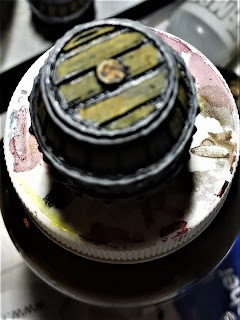The very awesome Stonehaven Minis had a figure so well-suited, he became the character basis for the next Pathfinder game I played. Meet the Dwaren Brewmaster. Have cask will travel...
So I'm still curious what the tool on his back not sure what it is but I think this is it. I'm going to call it a "brewing ladle" for now.
Brewmaster Color Scheme
- Kegs - as per other post
- Skin - Reaper Tanned Skin palette for skin, with a little Reaper HD Sunburt Skin wash.
- Apron - Base: FolkArt Butter Pecan, Shadow (Wash): FolkArt Walnut Brown, Highlights: FolkArt Linen
- Cuffs - Base: Vallejo Heavy Goldenbrown, Highlight: FolkArt Ochre Yellow
- Shirt - Reaper Military Grey and Reaper Misty Grey for raised cuff
- String Belt and Bands - Antique White
- Pants - FolkArt Cafe Latte, dark brown wash (FolkArt Walnut Grey)
- Shoes - Reaper Dusky Skin Highlight on tips and ankle, Reaper Dark Skin for mid foot, dark brown wash (FolkArt Walnut Grey)
- Hair - originally going to do dark tones - but decided on Reaper Ash Grey, Cloudy Grey, and Misty Grey
- Brewing Ladle - FolkArt Butter Pecan with dark brown wash
Beer Mug Color Scheme - all Heavy Glazes
- Handle - Reaper Ghoul Skin and FolkArt Butter Pecan
- Mug Edges - Reaper HD Tusk Ivory and Folk Art Sunflower
- Mug Face, Bottom - Folk Art Ochre Yellow, washed over with Reaper Golden Brown
- Mug Face, Middle - Reaper Golden Brown
- Mug Face, Top - Reaper Dark Skin
- Bubbles in Glass - Reaper Maiden Flesh
- Foam - Reaper Maiden Flesh and Reaper Stark Naked, wash of Folk Art Sunflower, then Reaper Golden Brown / Dark Skin
Nice thing about the mini is he has a raised surface for the pupil of the left eye. Under my jeweler's glasses that I notice the same was not the case for the right eye. Given the pose, I figured the figure was making a bit of a squint - which was a nice character touch.
As mentioned above, as I started painting on the tanned skin tones, I realized he just pops more with the white hair as a contrast.
As mentioned above, as I started painting on the tanned skin tones, I realized he just pops more with the white hair as a contrast.
First and second coats down, it was time to start the mug.
Darker yellow to show the transition (pardon the blurry photo)
Darker toward the top.
Too dark for a lager. But why would a dwarf be drinking a lager anyway. He should be drinking a stout.
Some final touches to make the foam look more like what a stout would be.
Here he is mounted on a base in the terraclips style wood floor.
And - of course - I hid magnets on the base so I could drop things like a mini keg on his base - and take it off when needed.






















